Track
Dividing numbers in Excel sounds easy until you realize there’s no divide button. And no DIVIDE() function either. If you've ever tried to split costs across a team, calculate average spend, or tidy up messy data, you've probably run into this, too. To work around this, we use the forward slash / in Excel.
In this guide, I’ll show you how to divide one cell by another, apply the same formula across a whole column, fix errors, keep your numbers whole when needed, and even use smart tricks like Paste Special.
Basic Division in Excel
In Excel, every formula starts with an equal sign =, and to divide, we use the forward slash /. So if we type =20/10, Excel gives us 2.
When our formulas get longer, like combining division with other operations, Excel follows the PEMDAS rule. That means it works out things in this order: parentheses, exponents, multiplication and division (from left to right), and then addition and subtraction.
Dividing with cell references
Typing numbers directly works, but cell references make our formulas more flexible.
Suppose A2 has 20 and B2 has 10. We can type =A2/B2 into C2 and get the same result: 2. Then, to apply the same formula all the way down, drag the little square at the bottom-right of the cell down the column (that’s called the fill handle, by the way).
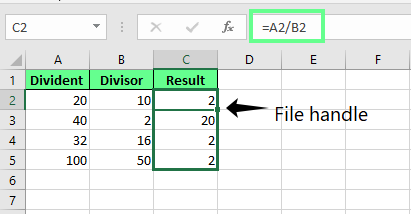
Divide the numbers using the cell references. Image by Author.
If we divide everything by the same number like the value in B2, we’ll want to lock that cell using an absolute reference like this: =A2/$B$2. That way, even when we drag the formula down, it always uses the value in B2.
Quick tip: Press F4 after clicking on the cell reference to add those dollar signs automatically.
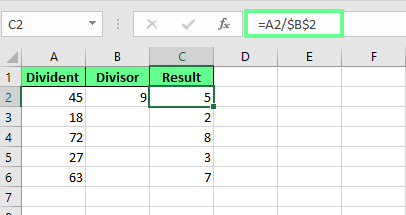
Divide the numbers using the absolute reference. Image by Author
Dividing using Paste Special
If you don’t want formulas in your sheet, I’ve a shortcut: First, copy the cell with the number you want to divide by. Then select the range of numbers you want to divide, right-click, choose Paste Special, then Divide. Or, if you love shortcuts, press Ctrl + Alt + V to open the Paste Special menu, then press I to pick Divide.
When you press OK, Excel replaces your original values with the results, leaving no formulas behind.
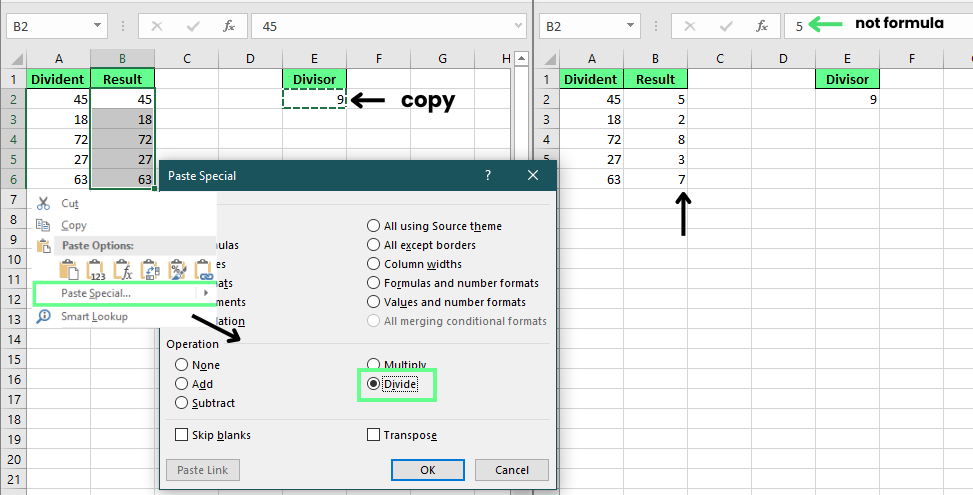
Divide the numbers using the Paste Special method. Image by Author.
Exploring Specialized Division Functions in Excel
Sometimes, we don’t need the full result of a division; we just want part of it. Maybe because we’re only interested in the whole number or need the leftover bit. Excel has two built-in functions that make this easy.
The QUOTIENT() function
This QUOTIENT() function returns only the whole number part of a division and leaves out anything extra. Here’s how it works:
QUOTIENT(numerator, denominator)So if we type =QUOTIENT(10, 7), Excel gives 1. That’s the whole number part of 10 divided by 7. If we’d used a normal division like =10/7, we’d see 1.43, but QUOTIENT() cuts off everything after the decimal.
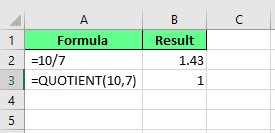
Divide the numbers using the QUOTIENT() function. Image by Author.
The MOD() function
The MOD() function returns the remainder, the leftover after division. Its syntax is:
MOD(number,divisor)If we use =MOD(10, 7), Excel returns 3. That’s because 7 fits into 10 once (7 × 1 = 7), and there’s 3 left over. You don’t have to do that math yourself because Excel handles it in one step.
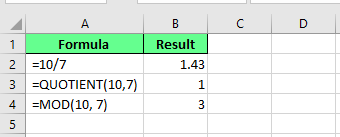
Use MOD() to find the remainder. Image by Author.
Dividing Multiple Ranges At Once
If you work with thousands of rows, typing out a separate formula for each can take forever. Luckily, we can handle this faster with array formulas. They let us apply the same calculation across multiple cells in one go.
Suppose we’ve numbers in cells A2 to A10 and we want to divide them by the numbers in B2 to B8. To do so, we select the cells where we want the results to appear. Then, in the formula bar, type:
=A2:A10/B2:B8Now press Ctrl + Shift + Enter so Excel converts it into an array formula. Once done, you’ll see curly braces {} appear around your formula. Excel then divides each value in the first range by the matching value in the second. So A2 is divided by B2, A3 by B3, and so on.
Bonus tip: If you try to edit part of the array, Excel warns, “You can’t change part of an array.” To update it, all you have to do is select the full range and make changes in the formula bar.
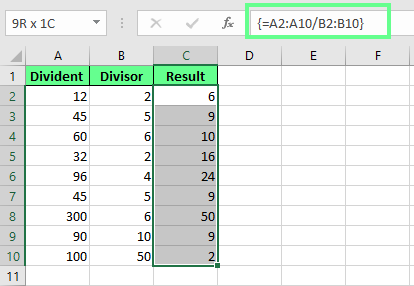
Divide the numbers using an array formula. Image by Author.
Other Interesting Division Problems in Excel
Let’s look at a couple of division problems in Excel that can mess up your work and how to fix them.
Handling division by zero (#DIV/0! Error)
If you try to divide a number by zero or by a blank cell, Excel throws the #DIV/0! error. That’s its way of saying, “I can’t divide by zero.” But we can fix this using IFERROR(). Here’s how:
=IFERROR(A2/B2, "")This formula tries to divide A2 by B2. If it works, great. If it doesn’t, Excel shows a blank cell instead of an error.

Handle #DIV/0! error with IFERROR() function. Image by Author.
If you want to show a message instead, you can do that too:
=IFERROR(A2/B2, "Error in calculation")Or, you can check for the zero yourself using the IF() function:
=IF(B2=0, "Can't divide by zero", A2/B2)That way, Excel only runs the division when it’s safe to do so.

Handle #DIV/0! error with IF() function. Image by Author.
Dividing by percentages
This one confuses a lot of people: When do you divide, and when do you multiply? Here’s a simple way to think about it:
- If you want to find a part of a number, multiply.
- If you want to work out the whole when you know a part and a percentage, divide.
For example, to find 30% of 70, we will multiply: =70*30% That gives us 21. But if we know 90 is 30% of something, and we want to find the full amount, we will divide: =90/30%. That gives us 300. We can also write the percent as a decimal (=90/0.3), and the result will be the same.
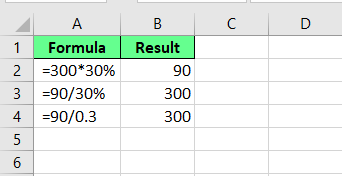
Divide a number by the percentages. Image by Author.
Ensuring Whole Number Results and Totals
Sometimes we don’t want decimals. If we’re splitting up items, packing boxes, or assigning tasks, we need whole numbers, not 2.3 boxes or 4.6 team members. Here’s how we can fix this:
Use INT() to round down
Excel’s INT() function is a simple way to round down to the nearest whole number. So if we divide 10 by 7, we normally get 1.43. But =INT(10/7) gives us 1. Nice and clean.
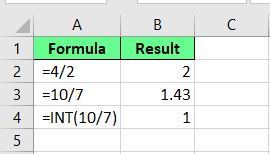
Use the INT() function to get a whole number. Image by Author
Combine INT() with MOD() to handle leftovers
What if we’re dividing something and there’s a remainder, like 16 items into boxes that hold 7 each? If we round down, we’ll miss a couple of items. To avoid that, we can use a combo of INT(), MOD(), and IF() to make sure nothing gets left out:
=IF(MOD(A2,7)>0, INT(A2/7)+1, INT(A2/7))Here’s what’s happening:
-
A2/7gives us how many full boxes we can fill. -
MOD(A2,7)checks for leftovers. -
If there are any, the formula adds one more box to fit the extras.
So, for 16 items, this formula gives us 3 boxes. It’s a neat way to make sure everything fits, even the leftovers.

Combine MOD() and INT() to distribute items equally. Image by Author.
Final Thoughts
And that’s a wrap. Whether you're using a simple formula, handy functions like QUOTIENT(), MOD(), or INT(), or even skipping formulas entirely with Paste Special, there’s a method to suit whatever you’re working on. We also covered how to handle tricky stuff like dividing by zero and how to make sure your results are whole numbers when that matters.
Now it’s your turn to give it a go. Open up Excel, try some of these methods, and see what works best for you. The more you practice, the quicker and easier it’ll feel.
If you want to keep building your skills, Datacamp has a list of Excel tutorials to help you learn Excel from basic to advanced. If you're into data analysis, check out the Data Analysis in Excel course or the Data Analysis with Excel Power Tools skill track.
I'm a content strategist who loves simplifying complex topics. I’ve helped companies like Splunk, Hackernoon, and Tiiny Host create engaging and informative content for their audiences.
FAQs
Can I divide two values from different worksheets in Excel?
Yes, you can divide values from different sheets by referencing the sheet name. For example, =Sheet1!A2/Sheet2!B2 divides the value in cell A1 of Sheet1 by B1 of Sheet2.
Or instead of typing the formula:
- Select the cell where you want to add the formula and enter
=. - Select the first cell.
- Then type the divide sign.
- Go to the other sheet and select the second cell.
- Press Enter.
How do I prevent Excel from changing the result of a division into a date?
Sometimes Excel misinterprets the result as a date when we write 10/5 or something similar. To fix this, change the cell format to General or Number before entering the formula.
How do I divide a number and round it to 2 decimal places?
You can use the ROUND() function like this: =ROUND(A1/B1, 2). It will divide and round the result to two decimal places.

